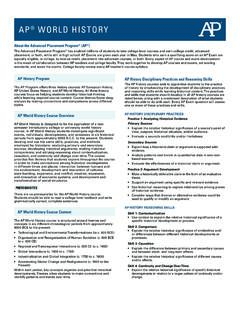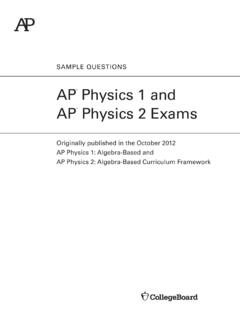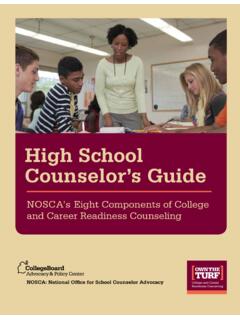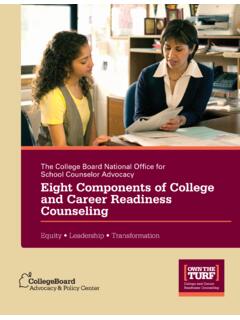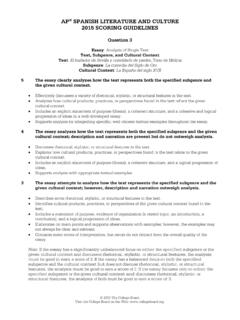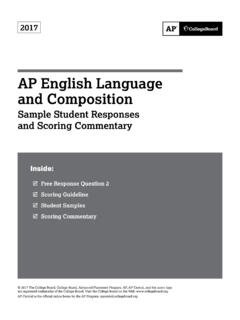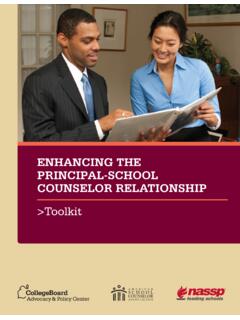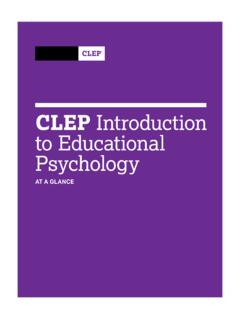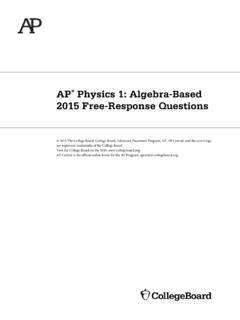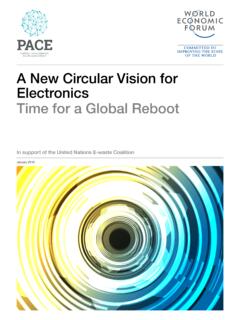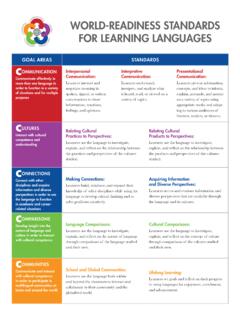Transcription of AP English Language and Composition 2010 Free-Response ...
1 AP English Language and Composition 2010 Free-Response Questions Form B. The College Board The College Board is a not-for-profit membership association whose mission is to connect students to college success and opportunity. Founded in 1900, the College Board is composed of more than 5,700 schools, colleges, universities and other educational organizations. Each year, the College Board serves seven million students and their parents, 23,000 high schools, and 3,800 colleges through major programs and services in college readiness, college admission, guidance, assessment, financial aid and enrollment. Among its widely recognized programs are the SAT , the PSAT/NMSQT , the Advanced Placement Program . (AP ), SpringBoard and ACCUPLACER . The College Board is committed to the principles of excellence and equity, and that commitment is embodied in all of its programs, services, activities and concerns.
2 2010 The College Board. College Board, ACCUPLACER, Advanced Placement Program, AP, AP Central, SAT, SpringBoard and the acorn logo are registered trademarks of the College Board. Admitted Class Evaluation Service is a trademark owned by the College Board. PSAT/NMSQT is a registered trademark of the College Board and National Merit Scholarship Corporation. All other products and services may be trademarks of their respective owners. Permission to use copyrighted College Board materials may be requested online at: Visit the College Board on the Web: AP Central is the official online home for the AP Program: 2010 AP English Language AND Composition . Free-Response QUESTIONS (Form B). English Language AND Composition . SECTION II. Total time 2 hours Question 1. (Suggested time 40 minutes. This question counts for one-third of the total essay section score.)
3 Directions: The following prompt is based on the accompanying six sources. This question requires you to synthesize a variety of sources into a coherent, well-written essay. When you synthesize sources, you refer to them to develop your position and cite them accurately. Your argument should be central; the sources should support the argument. Avoid merely summarizing sources. Remember to attribute both direct and indirect references. Introduction In much of the world , the time that regulates our lives is altered by daylight saving time . Each year, we set our clocks back an hour in the fall and then move them forward an hour in the spring. This annual shift is thought to have been invented by Benjamin Franklin, who in 1784 wrote a letter to a French journal suggesting that Parisians could economize on candles if they simply woke up earlier during the summer.
4 Daylight saving time was adopted by the United States in the twentieth century and is regulated by the federal government. Even though daylight saving time has been widely adopted, it still has detractors. Assignment Read the following sources (including the introductory information) carefully. Then synthesize at least three of the sources into an essay that evaluates daylight saving time and offers a recommendation about its continued use. You may refer to the sources by their titles (Source A, Source B, etc.) or by the descriptions in parentheses. Source A ( Extra! ). Source B (Longley). Source C (Prerau). Source D (graph). Source E (O'Connor). Source F (Kotchen). 2010 The College Board. Visit the College Board on the Web: GO ON TO THE NEXT PAGE. -2- 2010 AP English Language AND Composition .
5 Free-Response QUESTIONS (Form B). Source A. Extra!: Daylight-Saving time . Cable News Network, 7 March 2007. Web. 8 Aug. 2007. The following is excerpted from an article on a news Web site. 1918 - The first adopts daylight-saving time , in the same act that created standard time zones, in an effort to save energy during world War I. It didn't prove popular, and, as a result, it was repealed the following year. 1942 - President Franklin D. Roosevelt instituted war- time , a year-round daylight-saving time to save energy during world War II. After the year-round shift ended in 1945, many states adopted their own summer time changes. 1966 - Congress established a national pattern for summer time changes with the Uniform time Act. The act came in response from the transportation industry, which demanded consistency across time zones.
6 The Department of Transportation now oversees time changes in the United States. 1973 - An oil embargo by the Organization of Petroleum Exporting Countries led Congress to enact a test period of year-round daylight-saving time in 1974 and 1975. The test period was controversial; it ended after complaints that the dark winter mornings endangered children traveling to school. The returned to summer daylight-saving time in 1975. 1986 - The Federal law is amended to start daylight-saving time on the first Sunday in April, beginning in 1987. The ending date of daylight-saving time was never changed, and remained the last Sunday in October through 2006. 2005 - On August 8, President Bush signs the Energy Policy Act of 2005 into law. Part of the act will extend daylight-saving time starting in 2007, from the second Sunday in March to the first Sunday in November.
7 2007 - Daylight-saving time begins on Sunday, March 11 and ends on Sunday, November 4. Courtesy CNN. 2010 The College Board. Visit the College Board on the Web: GO ON TO THE NEXT PAGE. -3- 2010 AP English Language AND Composition . Free-Response QUESTIONS (Form B). Source B. Longley, Robert. Energy Bill Would Extend Daylight Savings time . The New York Times Company, 2008. Web. 17 Aug. 2009. The following is excerpted from an online article. An extra month of synthetic sunshine every year Love it or hate it, America's annual observance of daylight savings time would be extended one additional month under a provision of the massive Energy Policy Act of 2005.. Daylight Saving time for the and its territories is NOT observed in Hawaii, American Samoa, Guam, Puerto Rico, the Virgin Islands, the Eastern time Zone portion of the State of Indiana, and by most of Arizona (with the exception of the Navajo Indian Reservation in Arizona).
8 These states and territories remain on their local standard time throughout the year.. Theory has it that daylight savings time promotes energy conservation.. Studies done in the 1970s by the Department of Transportation show that America's electricity usage is reduced by about one percent during each day that daylight savings time is in effect. Also in the Energy Bill Other major provisions of the Energy Policy Act of 2005 include the allowance of oil drilling in an Alaska wildlife refuge and the creation of policies to shield makers of gasoline additives from future water contamination lawsuits. The bill also provides $12 billion in tax breaks and subsidies for energy companies .. 2008 by Robert Longley ( ). Used with permission of About, Inc., which can be found online at All rights reserved.
9 2010 The College Board. Visit the College Board on the Web: GO ON TO THE NEXT PAGE. -4- 2010 AP English Language AND Composition . Free-Response QUESTIONS (Form B). Source C. Prerau, David. Seize the Daylight: The Curious and Contentious Story of Daylight Saving time . New York: Thunder's Mouth, 2005. Print. The following is excerpted from a book about daylight saving time . Using a variety of analytical techniques, the DOT [United States Department of Transportation] study assessed the impacts of DST [daylight saving time ] in March and April and concluded that modest overall benefits might be realized in three primary areas energy conservation, traffic safety, and reduced crime by use of an eight-month DST system (March through October) rather than the Uniform time Act's six-month DST system (May through October).
10 Most subsequent studies of the effects of daylight saving time , performed in the United States, Britain, France, Israel, Mexico, New Zealand, and other countries, have produced somewhat similar results to the DOT study, especially with regard to the benefits of DST for energy conservation and traffic safety.. The DOT concluded that the total electricity savings associated with DST amounted to about 1 percent in spring and fall, corresponding to national savings of forty to fifty megawatt hours per day. DST also might affect home heating, air conditioning, and other forms of energy consumption. For example, the extra hour of light in the evening could cause an increase in recreational and shopping travel by automobile (and therefore an increase in gasoline consumption) that might not be offset by a corresponding decrease in the morning.
